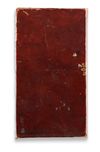Lot 22 AQRABADIN: CLASSIFICATIONS OF DISEASES, A MEDICAL TREATISE BY ABY BAKR AL-RAZI, WRITTEN BY SA'ID ALI AL-HUSAYNI AND DATED 994 AH/1586 AD
Arabic Manuscript on Paper, comprising 65 folios, each page features 20 lines of black naskh script. Headings and catchwords in red ink. The final page bears the inscription: “Written by Saʿid ʿAli al-Ḥusaynī”, and is dated 994 AH (1586 AD).
In a deep red leather binding.
10 by 19 cm.
The manuscript contains a succinct yet comprehensive medical treatise by the distinguished physician Abū Bakr al-Rāzī (865–925 AD), renowned for his pioneering contributions to medical science during the Islamic Golden Age. This work presents direct and practical remedies for a wide spectrum of diseases, organized into 61 concise chapters.
Al-Rāzī’s treatise addresses disorders ranging from hair conditions like baldness and alopecia, to neurological ailments including headaches, migraines, tremors, and epilepsy. It covers common illnesses such as colds and melancholia, alongside sensory afflictions of the eye, ear, and nose.
Further chapters focus on bleeding disorders, dental issues, respiratory complaints such as cough, and cardiac palpitations. Digestive maladies—including stomach ailments, liver and stomach tumors, and nausea—are treated with clarity and precision. The text also examines the impact of various medicines on body weight, as well as diseases of the spleen, kidneys, and bladder, urinary difficulties, childbirth, menstruation, and lactation.
Additional sections provide practical guidance on reproductive health, gout, sciatica, hemorrhoids, and dermatological conditions such as scabies, vitiligo, leprosy, ulcers, and smallpox.
Abū Bakr al-Rāzī, also known as Rhazes in the Latin West, was a Persian polymath—physician, philosopher, and alchemist—whose empirical approach and clinical insight revolutionized medieval medicine. His works, including the monumental Kitāb al-Ḥāwī and the widely influential Kitāb al-Manṣūrī, laid the groundwork for modern clinical practice.
This manuscript reflects al-Rāzī’s enduring legacy as a physician who combined rigorous observation with concise, practical medical guidance—an artful synthesis of knowledge aimed at effective treatment and patient care.
الأقراباذين: تقاسيم العلل – رسالة طبية لأبي بكر الرازي، كتبها سعيد علي الحسيني، مؤرخة بسنة 994هـ / 1586م
هذا العنوان يشير إلى نسخة من رسالة طبية مهمة تنسب إلى الطبيب الشهير أبو بكر الرازي، وتحمل عنوان "الأقراباذين"، وهو مصطلح يُستخدم في الطب الإسلامي للدلالة على كتب الأدوية المركبة وتصنيف الأمراض وعلاجاتها
يحتوي هذا المخطوط على رسالة طبية موجزة وشاملة من تأليف الطبيب البارز أبو بكر الرازي (865–925م)، المعروف بإسهاماته الرائدة في علم الطب خلال العصر الذهبي الإسلامي. يعرض هذا العمل علاجات مباشرة وعملية لطيف واسع من الأمراض، موزعة على 61 فصلاً مختصرًا.
تعالج رسالة الرازي اضطرابات متنوعة، بدءًا من مشاكل الشعر مثل الصلع والثعلبة، مرورًا بالأمراض العصبية كآلام الرأس، والصداع النصفي، والرعشة، والصرع. كما يغطي أمراضًا شائعة مثل الزكام، والمالنخوليا (السوداوية)، بالإضافة إلى أمراض الحواس كالعيون، والأذنين، والأنف.
تركز فصول أخرى على اضطرابات النزف، ومشاكل الأسنان، وأمراض الجهاز التنفسي مثل السعال، وخفقان القلب. كما يتناول الأمراض الهضمية، بما في ذلك أمراض المعدة، والأورام في الكبد والمعدة، والغثيان، بأسلوب دقيق وواضح. ويبحث النص كذلك في تأثير الأدوية المختلفة على وزن الجسم، إلى جانب أمراض الطحال والكلى والمثانة، وصعوبات التبول، والولادة، والحيض، والرضاعة.
تتضمن أقسام إضافية إرشادات عملية تتعلق بالصحة الإنجابية، وداء النقرس، وعرق النسا، والبواسير، وأمراض الجلد مثل الجرب، والبهاق، والجذام، والقروح، والجدري.
كان أبو بكر الرازي، المعروف في الغرب اللاتيني باسم "رازس"، عالمًا موسوعيًا فارسيًا — طبيبًا وفيلسوفًا وكيميائيًا — أحدثت طريقته التجريبية وبصيرته السريرية ثورة في الطب في العصور الوسطى. وقد أرست مؤلفاته، مثل "كتاب الحاوي" الضخم و"كتاب المنصوري" واسع التأثير، الأساس للممارسة السريرية الحديثة.
ويعكس هذا المخطوط الإرث الخالد للرازي كطبيب جمع بين الملاحظة الدقيقة والإرشاد الطبي العملي الموجز — توليفة فنية من المعرفة تهدف إلى العلاج الفعّال والعناية بالمريض.




